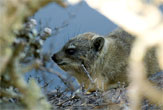
The giant asteroid that slammed into Earth 65 million years ago might have marked the beginning of the end for dinosaurs, but it was a mere speed bump in the evolution of modern mammals.
That is the conclusion of a new landmark study, detailed in the March 29 issue of the journal Nature, which maps the evolutionary relationships among nearly all mammals alive today.
The findings challenge a popular claim that the dinosaurs’ demise was what allowed the ancestors of modern mammals to stop cowering in the shadows of "terrible lizards" and flourish.
Mammalian Golden Age
The findings suggest mammals had already begun to diversify long before the asteroid-linked extinction event 65 million years ago that killed non-avian dinosaurs. The study reveals two major spikes in the otherwise steady evolution of modern mammals, both of which appear to be independent of the dino wipe-out.
One occurred around 93 million years ago, when the major divisions of living mammals—placentals, marsupials and monotremes, such as the platypus—began to appear. Most of these mammals—such as Andrewsarchus, an aggressive wolf-like cow—belonged to lineages that are either extinct or have dwindled drastically in numbers.
“It was other groups of mammals, not those we see today, that took advantage of the extinction of the dinosaurs,” said study team member Robin Beck of the University of New South Wales. The second evolutionary spike in modern mammalian history didn’t occur until about 10 to 15 million years after the dinosaurs’ demise, around the start of the Eocene era (about 55 to 34 million years ago), the researchers say. This was the mammalian Golden Age, when the preponderance of mammals, especially the ancestors of many groups alive today—such as primates, rodents and hoofed animals—really took off, according to the new study.
Get the world’s most fascinating discoveries delivered straight to your inbox.
Mammal map
The researchers used data gleaned from DNA studies and the fossil record to arrive at the findings about the spikes via a “supertree” they generated that estimates the dates when species diverged from a common ancestor. The supertree, which required more than a decade to complete, maps the evolutionary relationships among 4,510 of the 4,554 known mammal species alive today.
Why modern mammals took so long to flourish is still a mystery. “The big question now is what took the ancestors of modern mammals so long to diversify,” said study team member Ross MacPhee of the American Museum of Natural History. “It’s as though they came to the party after the dinosaurs left, but just hung around while all their distant relatives were having a good time.”
The researchers suggest the peak in the diversification of modern mammalian groups is associated with a bout of global warming and the subsequent emergence of flowering plants. But they say more research is needed to link the events.
More proof required
The question of when the ancestors of present-day mammals began to flourish has long been a bone of contention among paleontologists and molecular biologists.
“Extensive molecular data indicate our common mammalian roots have to go back 90 to 100 million years, if not more, but many paleontologists have been dubious of this claim given the lack of ancestral-looking fossils until about 50 to 55 million years ago,” MacPhee explained. “This new work helps reconcile those differences. Now we know the ancestors of living mammal groups were there, but in very low numbers.”
John Gatesy, a biologist at the University of California, Riverside, who has done research in both fields, said the new findings are interesting but that it will take more proof to convince him of the date of mammal diversification.
”These molecular dates have just been going back for the past 20 years,” Gatesy told LiveScience, adding that it will take concrete fossil evidence to convince him. “For me, if they found one rodent in the Cretaceous (144 million to 65 million years ago), it would be more interesting than this entire paper.”


